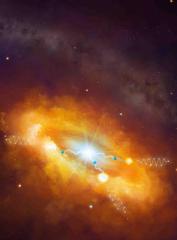URL: https://www.desy.de/news/news_search/index_eng.html
Breadcrumb Navigation
DESY News: Researchers locate particle accelerator of unprecedented energy in the centre of our galaxy
News
News from the DESY research centre
Researchers locate particle accelerator of unprecedented energy in the centre of our galaxy
Scientists of the H.E.S.S. Observatory have identified an area around the black hole in the centre of the Milky Way that emits intense gamma radiation of extremely high energy. The source of the radiation is an astrophysical accelerator speeding up protons to energies of up to one peta electronvolts (PeV) – more than 100 times higher than the largest and most powerful man-made particle accelerator, the Large Hadron Collider LHC at CERN. The scientists have now published their detailed analysis of recent H.E.S.S. data in the scientific journal Nature. The analysis shows the first identification of a source of cosmic rays with peta-electronvolt energy within the Milky Way: it is very likely the supermassive black hole at the centre of our galaxy itself.

The mirror telescopes of the H.E.S.S. observatormy in Namibia in front of the stars of the Milky Way (photo: Matthias Lorentz).
When gamma rays hit the Earth´s atmosphere, they produce short bluish flashes of light that can be detected by large mirror telescopes with fast light sensors at night. With this technique, more than 100 sources of high-energy gamma rays have been discovered in the sky over the past decades. Currently, H.E.S.S. is the most sensitive tool for their detection.

Artist´s view of the high energy accelerator in the centre of our galaxy: accelerated protons (blue) interact in dense molecule clouds around the centre and produce neutral particles which decay immediately emitting gamma rays (yellow waves). In the background a photo ov the Milky Way (picture: M.A. Garlick, H.E.S.S. Collaboration).
Detailed observations of the centre of the Milky Way, which were carried out with the H.E.S.S. telescopes during the past 10 years, now provide the first answers. “We have located an astrophysical accelerator accelerating protons to energies of up to one peta electronvolts, and that continuously over at least 1000 years,” says Prof. Christian Stegmann, head of DESY in Zeuthen and former spokesperson of the H.E.S.S. Collaboration.
Already during the first years of observation since 2002 H.E.S.S. had detected a strong compact source and an extended band of diffuse highest-energy gamma rays in the galactic centre. Evidence of this diffuse radiation, which covers an area of about 500 light years across, was already a clear indication of a source of cosmic rays in this region; proof of the source itself remained unfulfilled for the researchers. A significantly larger amount of observational data together with advances in analytical techniques have made it now possible to measure for the first time both the spatial distribution as well as the energy of the cosmic rays.
Although the central region of our Milky Way hosts many objects that can generate high-energy cosmic rays, for instance a supernova remnant, a pulsar wind nebulae and a compact star clusters, the measurement of gamma rays from the galactic centre provides strong evidence that the supermassive black hole at the galactic centre itself accelerates protons to an energy of up to one PeV. “Our data show that the observed glow of gamma rays around the galactic centre is symmetrical,” says H.E.S.S. researcher Stefan Klepser from Zeuthen. “The gamma rays are of a high energy and concentrated towards the centre, which suggests that they must be the echo of a huge particle accelerator which is located in the centre of this glow.” Prof. Stegmann adds that “several possible acceleration regions can be considered, either in the immediate vicinity of the black hole, or further away, where a fraction of the material falling into the black hole is ejected back into the environment, potentially initiating the acceleration of particles.“
However, the analysis of the measurements also shows that this source alone cannot account for the total flux of cosmic rays detected on Earth. “If, however, our central black hole has been more active in the past”, the researchers argue, “then it might actually be responsible for the entire bulk of today´s galactic cosmic rays”. If their assumption is correct, the 100-year-old mystery of the origin of cosmic rays would be solved.



